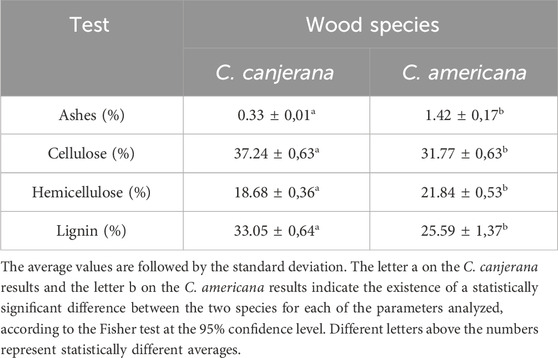- 1Chemical and Environmental Engineering Department, University of the Basque Country, Donostia-San Sebastian, Spain
- 2Post-Graduate Program in Materials Science and Engineering, Federal University of Pelotas, Pelotas, Brazil
- 3Building Technician, Federal Institute of Education, Science and Technology Sul-rio-Grandense, Pelotas, Brazil
- 4Post-Graduate Program in Materials Science and Engineering, Federal University of Pampa, Bagé, Brazil
- 5Post-Graduate Program in Biotechnology, Federal University of Pelotas, Capão do Leão, Brazil
- 6Wood Industrial Engineering, Federal University of Pelotas, Pelotas, Brazil
- 7Engineering Center, Federal University of Pelotas, Pelotas, Brazil
Cabralea canjerana and Cordia americana, two Brazilian tree species found across various states, serve a range of applications from sawmill products to folk medicine. The extractives, non-structural wood components, are utilized for diverse purposes, including natural dyes, preservatives, and medicinal products. After a comprehensive search of the literature, no publications were found characterizing the chemical composition of C. canjerana and C. americana wood. This increases the need to research these species and learn more about their potential. The vast diversity of Brazil’s tree species sometimes complicates the selection process for extraction purposes, highlighting the importance of anatomical wood identification. This study evaluates the presence of fine molecules with important biological activity or industrial value in the wood extractives of C. canjerana and C. americana, proposing potential uses for the extracted lignocellulosic biomass and providing anatomical identification support for these species. Characterization methods of the wood included analysis of ash, hemicellulose, cellulose, and lignin content. Extraction techniques employed ethanol, ethanol-toluene, hot water, and 1% soda, followed by gas chromatography-mass spectrometry (GC-MS) for chemical analysis. Anatomical characteristics were determined using histological slides. The results show that Cordia americana displayed a 53.61% holocellulose content in relation to the dry mass, suitable for paper production, while Cabralea canjerana, with a 55.92% content, was deemed even more appropriate. GC-MS analysis identified several significant molecules in the extractives, including Phenol, 2,4-bis(1-phenylethyl), which is potentially effective in breast cancer drug development, and Gestrinone, a possible treatment for endometriosis. The anatomical examination of the C. canjerana and C. americana samples confirmed their species identity, aligning with the study’s objectives.
1 Introduction
In recent years, intensified research has focused on plant species that remain little explored or unidentified, to serve in different areas in increasingly demanding markets (Coelho et al., 2016; Bhardwaj et al., 2020; Chan et al., 2020; Eller et al., 2020; Hassan et al., 2020; Zhou et al., 2020; Zwingelstein et al., 2020). Although Brazil is a leader in flora diversity, a substantial portion of its plant life remains underutilized or unknown, especially for high-value applications, primarily due to an inadequate understanding of its exploitation potential (Stegmann et al., 2024).
In this context, there are Cabralea canjerana (Vell.) Mart. and Cordia Americana (L.) Gottschling and J. S. Mill., two Brazilian tree species that are present across the nation, predominantly in the Southeast and South Regions, characterized by predominant tropical and subtropical climates. The wood of both species exhibits remarkable natural durability, while their bark, leaves, and seeds find use in traditional medicine for treating various diseases (Carvalho, 2003). Moreover, the wood serves in constructing sleepers, roof structures, floors, frames, furniture, and skirting boards, showcasing its versatility (Carvalho, 2003; Gonzaga, 2006; Rodrigues et al., 2008; Almeida, 2013). After a comprehensive search in the literature, no publications were found characterizing the chemical composition of C. canjerana and Cordia americana wood. This increases the need to research these species and learn more about their potential. Especially about the existence of fine molecules with important biological activity or industrial value.
Wood extractives, non-structural components concentrated mainly in the heartwood, enhance wood’s natural durability by imparting resistance to biological degradation through their antifungal and insecticidal properties (Kirker et al., 2013; Mbakidi-Ngouaby et al., 2018).
The sustainable extraction process utilizes by-products or waste from the timber industry, such as wood chips, knots, branches, and sawdust, as raw materials, thereby increasing the process’s sustainability (Eller et al., 2020). These extractives, ranging from natural dyes to preservatives and medicinal compounds, allow the remaining lignocellulosic biomass to serve other purposes once extracted, thus reducing the environmental impact of forestry activities and offering economic benefits (Wang et al., 2011; Zule et al., 2016; Wen et al., 2019). To maximize extraction yields, the biomass must be ground and the resulting sawdust used for extraction (Kumar et al., 2011). This increases the contact surface with the solvent and thus the efficiency of the process (Mbakidi-Ngouaby et al., 2018; Setiawan et al., 2020).
Chemical characterization of the wood for extractive retrieval is essential for understanding the composition of these raw materials and, consequently, for assessing possible uses for the solid extraction residue (Surup et al., 2020), which is mainly composed of the structural components of the wood, namely, cellulose, hemicellulose, and lignin, constituting a lignocellulosic biomass (Strehmel et al., 2017).
Due to the immense variety of tree species in Brazil (Carvalho, 2003; 2006; 2008; 2010; 2014; Marchiori et al., 2009; Marchiori et al., 2010), mistakes can occur when selecting the wood to be used in extractions, resulting in extractives from an unwanted species. To avoid this risk, anatomical identification of the wood can be carried out, allowing the species to be confirmed based on its characteristics. This can be done using histological slides, which allow the observation of the anatomical characteristics of the wood cells under a microscope (Burger and Richter, 1991).
This work aims to evaluate the presence of fine molecules in the extractives of C. canjerana and C. americana wood, as well as to suggest possible uses for the extracted lignocellulosic biomass and to provide support material for the anatomical identification of the wood of these two species.
2 Materials and methods
2.1 Characterization of the raw material
For the chemical characterization of C. canjerana and C. americana wood, the study utilized samples obtained from a sawmill in São Domingos do Sul, Brazil. These samples were ground, and the portion that passed through a 40 mesh sieve was selected for analysis (TAPPI T 264, 2007). The characterization process included determining the ash content (TAPPI T 211, 1993) and measuring the levels of structural components, specifically hemicellulose (Wise et al., 1946), cellulose (Rowell, 1983), and lignin (TAPPI T 222, 1998). The number of samples for each test was five.
2.2 Obtaining extractives
Extractives were obtained from the sawdust of C. canjerana and C. americana wood using four different solvents and five samples for each assay, as described below:
• Extractives Soluble in Hot Water (TAPPI T 207, 1993): A mixture of sawdust and hot water (100°C) at a solid-to-liquid ratio of 2:100 (w:v) was placed in an Erlenmeyer flask and subjected to reflux for 3 h. Subsequently, the mixture was filtered through a No. 2 porous plate filter, washed with hot water at 60°C, and the extractives were dried in an oven to a constant weight.
• Extractives Soluble in 1% Sodium Hydroxide (TAPPI T 212, 1998): A blend of sawdust and a 1% sodium hydroxide aqueous solution, at a solid-to-liquid ratio of 2:100 (w:v), was combined in an Erlenmeyer flask. The flask was covered and placed in a thermostatic bath at 100 °C for 1 h. Afterward, it was vacuum filtered using a No. 1 porous plate filter and washed with 100 mL of hot water at 60 °C. Following the collection of the solvent with the extractives, the vacuum was halted, and the fibers were treated with 25 mL of 10% acetic acid for 2 min and the fibers were rinsed again with water to a neutral pH before drying in an oven to a constant weight.
• Extractives Soluble in Ethanol-Toluene (TAPPI T 204, 1997): Using the Soxhlet system, extractives were extracted with ethanol-toluene at a 1:2 (v:v) ratio. The heating temperature was adjusted so that a reflux occurred every 15 min. After 6 h of reflux, the extractives were dried in an oven to a constant weight.
• Ethanol-Soluble Extractives: The sawdust sample underwent maceration at 50°C for 4 h with a solid-liquid ratio of 1:10 (w:v), under magnetic stirring, using ethanol as the solvent, a standard procedure for wood maceration according to Santos et al. (2022). The material was then vacuum filtered using a Kitasato, Buchner funnel, and filter paper. The extractives was concentrated using a rotary evaporator - and dried in an oven at 50°C.
2.3 Gas chromatography-mass spectrometry (GC-MS)
The extractives from C. canjerana and C. americana, derived through ethanol, ethanol-toluene, hot water, and 1% soda extractions, were analyzed using gas chromatography-mass spectrometry (GC-MS) to determine their components. The samples, dissolved in ethyl acetate and methanol, at an extractive-solvent ratio of 1:1,000 (w:v), were automatically injected into a GC-MS QP-2010 system (Shimadzu, Kyoto, Japan) utilizing helium as the carrier gas through an RTX-5 ms capillary column (30 m × 0.25 mm x 0.25 µm). Following the procedure outlined by Hernández-Ramos et al. (2020), the analysis began at a temperature of 50°C. Subsequently, the temperature increased to 120°C at a rate of 8°C/min and was maintained for 5 min, then elevated to 280°C at the same rate and held for 8 min, followed by an increase to 300°C at 10°C/min, where it remained for 2 min. Mass spectra were acquired in the m/z range of 70–1,000 at a frequency of two scans per second.
2.4 Anatomical identification of wood species
The samples of C. canjerana and C. americana were identified by their anatomical characteristics, for which histological wood slides were prepared. To soften the wood and facilitate the cutting of histological slides, the wood samples were placed in beakers with water and heated to 100°C. The softening process lasted 24 h for C. americana and 80 h for C. canjerana. Subsequently, slides were prepared using a microtome (Leica SM 2010R), achieving thicknesses between 14 and 16 µm. These slides were immersed for 8 min in a 0.05 g toluidine blue dye solution (Sigma Aldrich) in 100 mL of water; following the removal of excess dye, they were then immersed in a 0.5 g safranine dye solution (Dinâmica Química Contemporânea) in 100 mL of water for another 8 min. The slides were further treated with ethyl alcohol at concentrations of 30%, 50%, 70%, and 95% for 5 min each and then stored in a Petri dish containing xylene. For mounting, the adhesive Entellan Novo (Merck) was applied to secure the histological slide to the coverslip and glass slide.
The analysis of the optical microscope slides was conducted by Opton TNB-04T-PL, assisted by a 13 Megapixel digital camera attached to a Zeiss Stemi SV11 optical magnifier. The ImageJ software was employed for image processing.
3 Results
3.1 Characterization of the raw material
The percentage of structural components and inorganic material (ashes) present in the wood of the C. canjerana and C. americana species is shown in Table 1. The values are expressed as a percentage in relation to the dry wood sawdust.
The sum for each wood species does not reach 100% because the remaining fraction corresponds to extractives, which are non-structural components. The wood of C. canjerana had cellulose content around 17% higher than the wood of C. americana. The ash content of C. canjerana was approximately 4.3 times lower than that of C. americana. The content of hemicellulose was around 17% higher in C. americana than in C. canjerana. The lignin content was approximately 29% higher in C. canjerana than in C. americana.
3.2 Extractives yield
Figure 1 shows the extractive yields of C. canjerana and C. americana obtained using different techniques and solvents. The yields are based on the initial mass of dry sawdust. Considering the Fisher test at the 95% confidence level, the extraction yields were different for the two species, with C. americana showing higher yields for extraction with hot water and ethanol-toluene, while C. canjerana showed a higher yield for extraction with soda. The exception was extraction with ethanol, in which the two species showed statistically the same yield. For the ethanol extraction, the average yield of the C. americana samples was 10.43% and the standard deviation was 2.94%, while for the C. canjerana samples the average yield was 15.07% and the standard deviation was 0.58%, but the Fisher test indicated that there was no statistical difference, as the P-value was 0.0549. For both species, extraction with the soda solution had the highest yield.
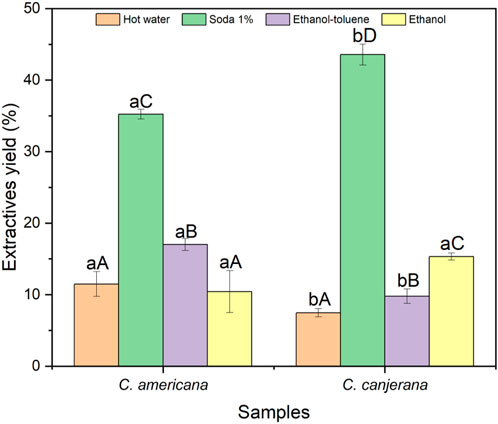
Figure 1. Yield of the extractives obtained under different conditions. Different lowercase letters indicate a statistically significant difference between species and different uppercase letters indicate a statistically significant difference between ways of extracting. Note: Vertical lines represent the standard deviation.
3.3 Gas chromatography-mass spectrometry (GC-MS)
Figures 2, 3 present the GC-MS chromatograms of the extractives of C. canjerana and C. americana wood, obtained from extractions with ethanol, ethanol-toluene, hot water and soda (1%) and dissolved in ethyl acetate and methanol.
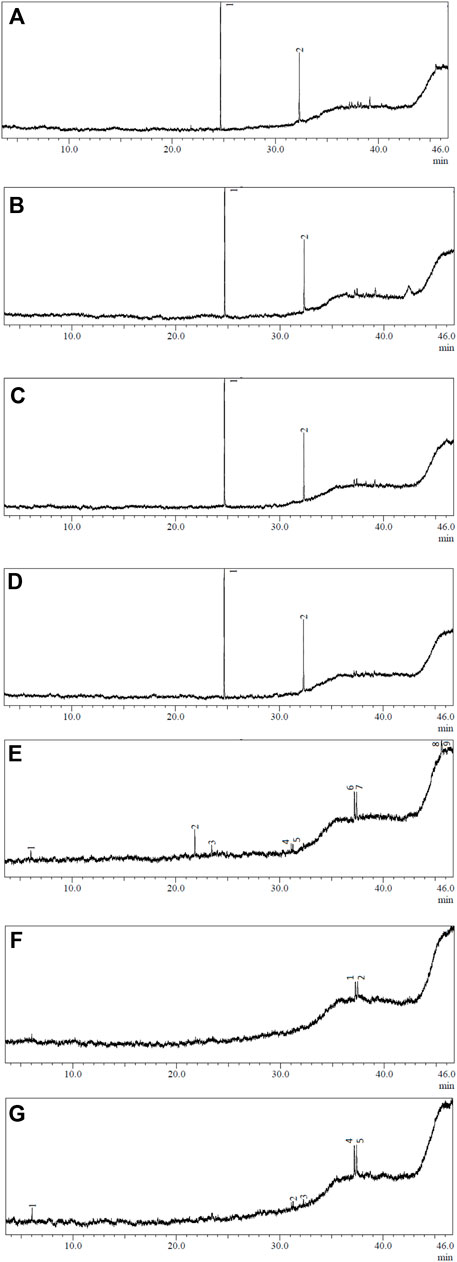
Figure 2. GC-MS chromatograms obtained with ethyl acetate dissolution of C. canjerana extractives extracted with: (A) ethanol-toluene, (B) hot water, (C) soda (1%) and (D) ethanol. GC-MS chromatograms obtained with dissolution in methanol of C. canjerana extractives extracted with: (E) ethanol-toluene, (F) hot water and (G) soda (1%). The retention time is expressed in minutes.
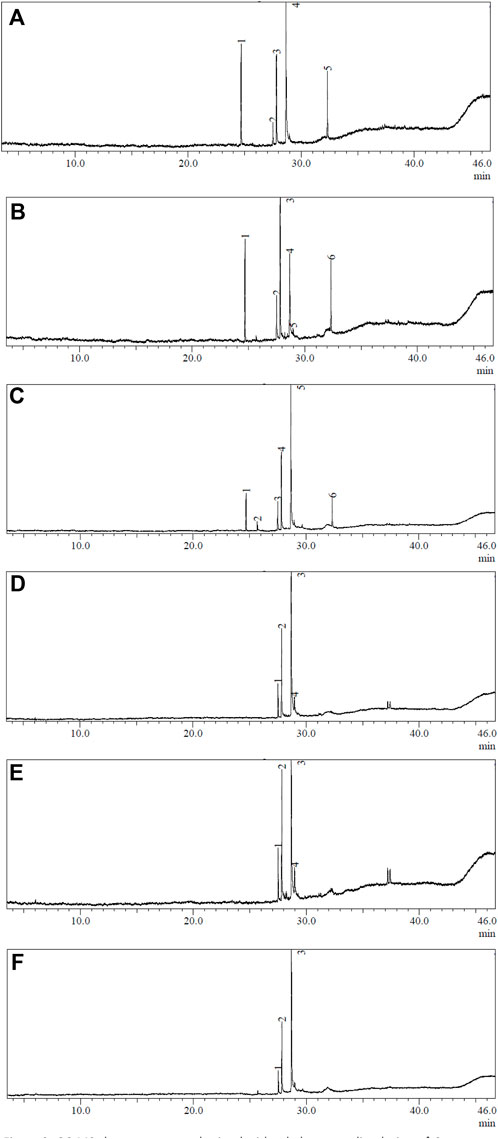
Figure 3. GC-MS chromatograms obtained with ethyl acetate dissolution of C. americana extractives extracted with: (A) ethanol-toluene, (B) hot water and (C) ethanol. GC-MS chromatograms obtained with dissolution in methanol of C. americana extractives extracted with: (D) ethanol-toluene, (E) hot water and (F) ethanol. The retention time is expressed in minutes.
Table 2 lists all the molecules present in the chromatograms that coincided with the library of the equipment. Thus, the small peaks present in the chromatograms, which were not listed, did not correspond to the library. The molecules were grouped according to the species of wood used, the solvent used to obtain the extractives and the solvent used in the GC-MS to solubilize the samples.
3.4 Anatomical identification of wood species
3.4.1 Cabralea canjerana
Based on slide observations (Figure 4), the cross-section reveals distinct growth rings bordered by marginal parenchyma (Marchiori et al., 2010). The pores display a uniform diffuse distribution, existing as solitary units or in radial multiples of 2 to 3, occasionally more, with an oval to circular cross-section (Rodrigues et al., 2008). Frequently observed in the heartwood are resin-like deposits that sometimes block the vascular cavities (Marchiori et al., 2010). The axial parenchyma exhibits a confluent aliform paratracheal type, creating marginal sinuous bands wider than three cells, characterized as serial and non-stratified (Rodrigues et al., 2008).
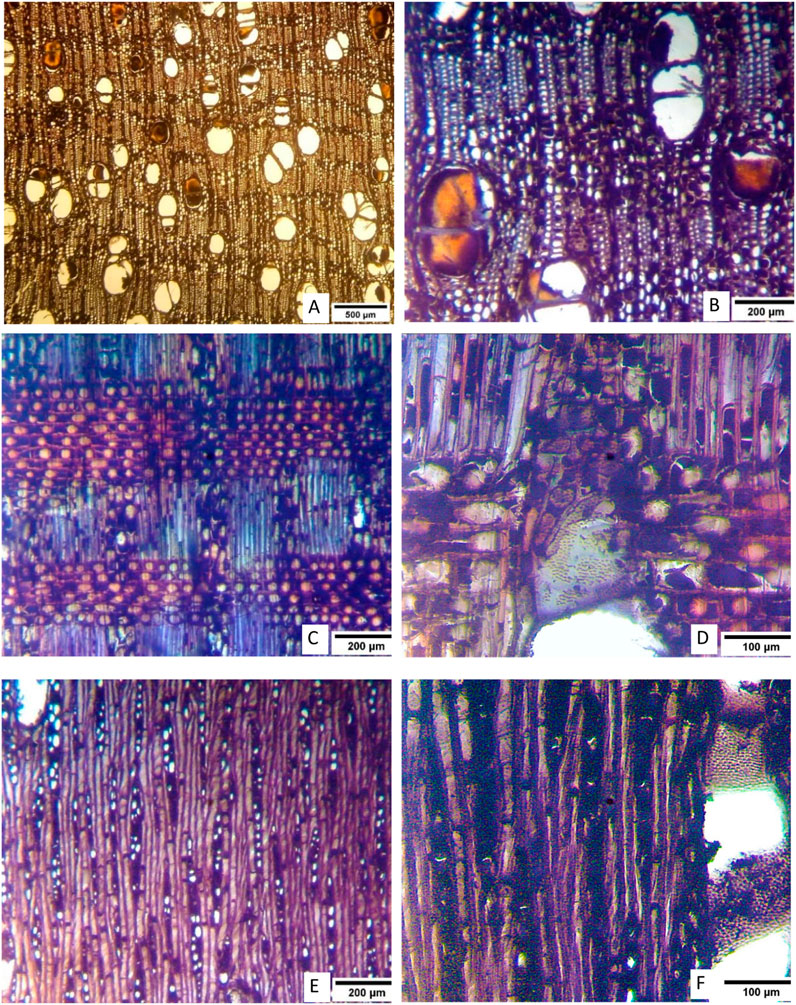
Figure 4. Anatomical aspects of Cabralea canjerana wood. (A, B) Cross section. (C, D) Radial longitudinal section. (E, F) Tangential longitudinal section. Source: Prepared by the authors.
In the radial section, vessel-ray and vessel-parenchyma pits appear alternating and rounded (Cury, 2001). The rays are heterogeneous, consisting of procumbent, square, and erect cells (Marchiori et al., 2010). Fibers are septate, featuring simple, semi-bordered, and bordered pits, with fiber wall thickness varying from thin to thick (Cury, 2001).
The tangential section illustrates that vessel elements have simple perforation plates (Rodrigues et al., 2008). Intervessel pits resemble those between vessels and parenchyma but are larger (Cury, 2001). Uniseriate rays, primarily composed of procumbent cells or with a marginal row of square cells, dominate, ranging from 1 to 25 cells in height. Although most multiseriate rays are two cells wide, a few extend to three cells wide; they contain procumbent cells in the multiseriate portion and square, erect cells at the margins, with heights between 5 and 37 cells (Marchiori et al., 2010).
3.4.2 Cordia americana
In the cross-section, distinct growth rings are observed (Almeida, 2013), demarcated by thin bands of marginal parenchyma and ray thickening (Figure 5). Besides these bands, the axial parenchyma exhibits types such as vasicentric, confluent vasicentric, aliform, confluent aliform paratracheal, and diffuse in aggregates apotracheal (Richter and Dallwitz, 2019). The pores demonstrate diffuse porosity, featuring solitary pores, radial multiples of 2 to 3 (Machado, 2016), and racemiform multiples. There is a pattern of semi-circular ring porosity, with pores arranged in tangential chains (Richter and Dallwitz, 2019). Oil/resin frequently blocks several pores (Almeida, 2013).
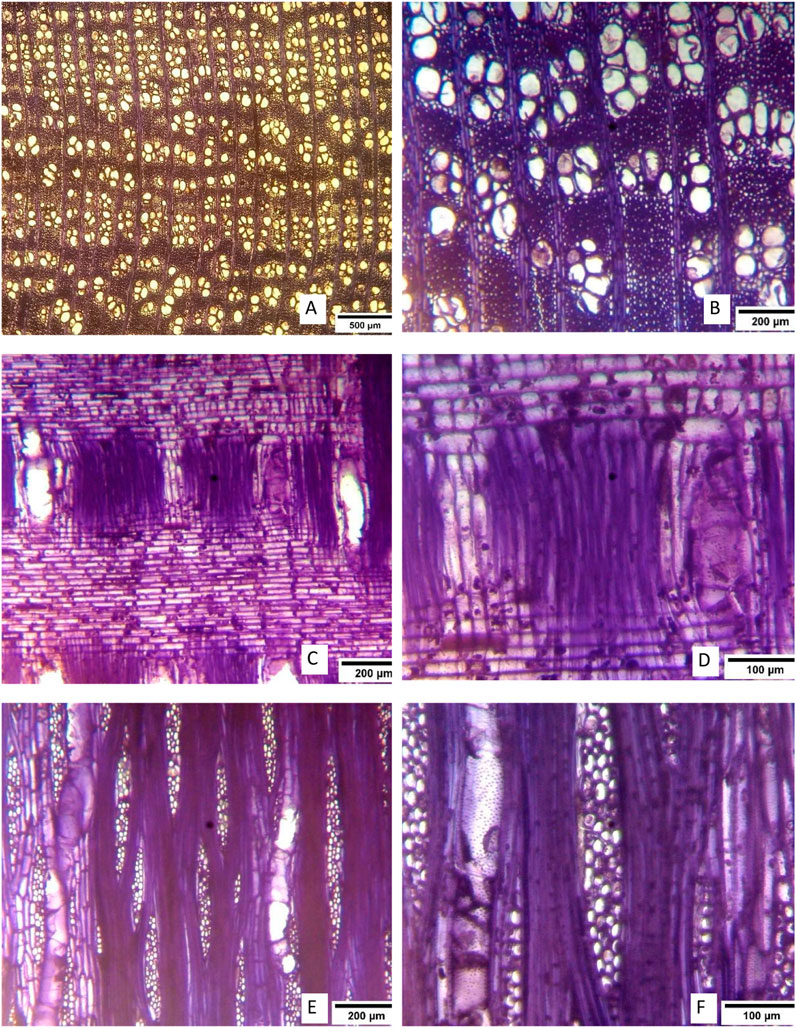
Figure 5. Anatomical aspects of Cordia americana wood. (A, B) Cross section. (C, D) Radial longitudinal section. (E, F) Tangential longitudinal section. Source: Prepared by the authors.
In the radial section, vessel-ray pits appear alternate and bordered. Observed solely on radial walls, the fiber pits are simple or have very small borders. The rays are heterogeneous, primarily consisting of procumbent cells with square and erect cells located in marginal rows (Richter and Dallwitz, 2019).
The tangential section reveals that vessel elements have simple perforation plates. The intervessel pits are alternate and bordered, with the observation of tyloses in the vessel elements’ lumen. The rays are identified as multiseriate, with their width spanning from 2 to 5 cells (Richter and Dallwitz, 2019).
4 Discussion
4.1 Characterization of the raw material
For C. americana, the combined cellulose and hemicellulose content, or holocellulose, reached 53.61% (Table 1), indicating the biomass’s potential for paper production. Cabralea canjerana exhibited a holocellulose content of 55.92%, rendering it even more appropriate for paper production post-extractive removal, especially since a holocellulose percentage above 33% suggests suitability for the paper industry. Moreover, the ash contents of 0.33% for C. canjerana and 1.42% for C. americana are below the 2.87% found in Eucalyptus grandis, commonly used in paper production. Lower ash contents facilitate energy and time savings during paper production, as ash removal is necessary (NagarajaGanesh et al., 2023). Post-extraction, the lignocellulosic biomass from both species also serves as a primary material for Medium Density Fiberboard (MDF) production, leveraging the wood fibers (Esshelf, 2017).
4.2 Extractives yield
Soxhlet extraction yields using ethanol-toluene were 17.01% for C. americana and 9.79% for C. canjerana, therefore showed higher yields than other species cited in the bibliography using the same extraction method. Such as Castanea sativa at 7.4% (D’Auria et al., 2021), Schizolobium parahyba at 2%, Pinus taeda at 6% (Mattos et al., 2014), and eucalyptus hybrids at 5% (Santos et al., 2011). Section 4.4 will discuss potential reasons for these high yields with ethanol-toluene.
The yield of extraction with 1% sodium hydroxide was 35.23% for C. americana and 43.56% for C. canjerana. Ali et al. (2019) extracted wood from different species using 1% sodium hydroxide. The authors found yields of 28.29% for Parthenium argentatum, 19.17% for Parthenium tomentosum, 31.30% for Asclepias syriaca and 17.10% for Acer rubrum, so there is considerable variation from one species to another. The high yield of extraction with 1% sodium hydroxide is possibly due to the fact that in addition to non-structural extractives, lignin and hemicellulose are also obtained.
4.3 Gas chromatography-mass spectrometry
In a GC-MS chromatogram, the retention time is dependent on the properties of the chemical structure of the substance, the capacity and dimensions of the column, the chemical nature of the mobile and stationary phase and the flow rate of the mobile phase (Moldoveanu and David, 2017). Thus, it is possible to understand that the longer the retention time, the greater the force of interaction between the substance and the stationary phase (Simomukay et al., 2022). In addition, the peak area and the peak height are proportional to the concentration of the compounds present in the analyte (Laajimi et al., 2022). It was possible to observe that the compounds that remained for longer in the stacionary phase were lilac alcohol epoxide and silicic acid, diethyl bis(trimethylsilyl) ester. Regarding to the concentration, it can be said that diisobutyl phthalate and phenol, 2,4,6-tris(1-phenylethyl)- were more present in the substances studied. In this way, the GC-MS analysis facilitated the identification of various molecules in the extractives from C. canjerana and C. americana, as detailed in Table 2. Notable among these molecules were Phenol, 2,4-bis(1-phenylethyl), which, according to Muhammed Ashraf et al. (2020), shows potential in the development of breast cancer treatments, and Gestrinone, identified by Lobo et al. (2008) as a candidate for endometriosis therapy. Additionally, Diisobutyl phthalate and Bis(2-ethylhexyl) phthalate, recognized for their wide range of industrial applications (Huang et al., 2021), were found in the extractives of both species in significant quantities, using various solvents, such as ethanol-toluene, hot water, hot water and soda (1%), and ethanol.
4.4 Anatomical identification of wood species
The anatomical features of C. canjerana and C. americana were examined across three planes in histological slides: cross-sectional, radial, and tangential. These features were then cross-referenced with the existing literature on these species (Cury, 2001; Rodrigues et al., 2008; Marchiori et al., 2010; Almeida, 2013; Machado, 2016; Richter and Dallwitz, 2019), affirming that the specimens used in this study indeed corresponded to the identified species. The observation of a significant number of parenchymatous cells, encompassing both radial and axial parenchyma, alongside the frequent occurrence of resin-blocked vessel elements in the slides, contributes to understanding the elevated extraction yields (Burger and Richter, 1991; Díaz, 2017). The presence of tyloses in the vessel elements of Cordia Americana also contributes to the high yields of extractions of this species, as tyloses are the occlusion of vessels by parenchymatous cells (Florsheim et al., 2020; Acosta et al., 2021).
5 Conclusion
GC-MS analysis facilitated the identification of noteworthy molecules within the extractives of C. canjerana and C. americana, particularly highlighting Phenol, 2,4-bis(1-phenylethyl), and Gestrinone. These compounds exhibit significant potential for healthcare applications, underscoring the broader implications of our findings in medical and pharmaceutical research.
Further, the chemical characterization of the wood underlines its versatility, proposing two primary applications for the extracted lignocellulosic biomass: the production of paper and Medium Density Fiberboard (MDF). This suggests that beyond their immediate scientific value, the use of extractives can contribute to sustainable manufacturing practices, offering a dual benefit of environmental conservation and economic efficiency.
Histological analysis played a crucial role in validating the species origin of the wood samples used in this study. The creation of histological slides from C. canjerana and C. americana provided not only a methodological foundation for species confirmation but also generated visual data to aid other researchers in species identification. The clarity and reliability of these images ensure they can serve as valuable reference material within the scientific community.
Moreover, the examination of wood’s anatomical features shed light on the mechanisms behind the high extraction yields obtained. Understanding these anatomical factors is crucial for optimizing extraction processes in future studies. The ability to achieve such high yields is particularly beneficial, as it enhances the efficiency of isolating fine molecules in substantial quantities, thereby facilitating more comprehensive studies on their properties and potential applications.
In conclusion, this research enhances our understanding of the chemical and anatomical properties of C. canjerana and C. americana, facilitating their potential use in health sciences and materials engineering. The results highlight the critical role of multidisciplinary methods in the investigation of natural resources, providing valuable insights that may contribute to breakthroughs in drug development and the creation of sustainable materials.
Data availability statement
The original contributions presented in the study are included in the article/supplementary material, further inquiries can be directed to the corresponding author.
Author contributions
MS: Conceptualization, Data curation, Formal Analysis, Investigation, Methodology, Writing–original draft, Writing–review and editing. EM: Formal Analysis, Writing–review and editing. AL: Data curation, Formal Analysis, Investigation, Writing–original draft. MR: Data curation, Formal Analysis, Investigation, Writing–original draft. PS: Investigation, Methodology, Writing–review and editing, Writing–original draft. SF: Data curation, Formal Analysis, Investigation, Methodology, Writing–original draft, Writing–review and editing. DG: Funding acquisition, Resources, Supervision, Writing–review and editing.
Funding
The author(s) declare that financial support was received for the research, authorship, and/or publication of this article. The authors would like to thank the Coordination for the improvement of Higher Level Personnel (CAPES) and the National Counsel of Technological and Scientific Development (CNPq) for the resources destined for the laboratory, which were of great importance for the development of this work.
Acknowledgments
MS would like to thank to the Federal Institute of Education, Science and Technology Sul-rio-grandense for granting him paid permission to do his doctorate.
Conflict of interest
The authors declare that the research was conducted in the absence of any commercial or financial relationships that could be construed as a potential conflict of interest.
Generative AI statement
The author(s) declare that no Generative AI was used in the creation of this manuscript.
Publisher’s note
All claims expressed in this article are solely those of the authors and do not necessarily represent those of their affiliated organizations, or those of the publisher, the editors and the reviewers. Any product that may be evaluated in this article, or claim that may be made by its manufacturer, is not guaranteed or endorsed by the publisher.
References
Acosta, A. P., Barbosa, K. T., Amico, S. C., Missio, A. L., de Avila Delucis, R., and Gatto, D. A. (2021). Improvement in mechanical, physical and biological properties of eucalyptus and pine woods by raw pine resin in situ polymerization. Industrial Crops Prod. 166 (March), 113495. doi:10.1016/j.indcrop.2021.113495
Ali, A., Chua, B. L., and Chow, Y. H. (2019). An insight into the extraction and fractionation technologies of the essential oils and bioactive compounds in Rosmarinus officinalis L.: past, present and future. Past, present future’, TrAC - Trends Anal. Chem. Elsevier Ltd 118, 338–351. doi:10.1016/j.trac.2019.05.040
Almeida, V. (2013). Avaliação do potencial de uso de resíduos de madeira tropical para produção de painéis colados lateralmente - EGP. Univ. Fed. do Paraná, 123.
Bhardwaj, K., Islam, M. T., Jayasena, V., Sharma, B., Sharma, S., Sharma, P., et al. (2020). Review on essential oils, chemical composition, extraction, and utilization of some conifers in Northwestern Himalayas. Phytotherapy Res. 34 (11), 2889–2910. doi:10.1002/ptr.6736
Brooke, D., Burns, J., Cartwright, C., and Pearson, A. (2009). Environmental risk evaluation report: styrenated phenol. Bristol: Environment Agency.
Carvalho, P. E. R. (2003). Espécies arbóreas brasileiras, Vol. 1. Brasília: Embrapa. doi:10.1515/9781501516023
Chan, Y. H., Loh, S. K., Chin, B. L. F., Yiin, C. L., How, B. S., Cheah, K. W., et al. (2020). “Fractionation and extraction of bio-oil for production of greener fuel and value-added chemicals: recent advances and future prospects,”, 397. doi:10.1016/j.cej.2020.125406Chem. Eng. J. 125406
CHEBI (2017). Cadalene, chemical entities of biological interest. Available at: https://www.ebi.ac.uk/chebi/searchId.do?chebiId=CHEBI:89476 (Accessed February 9, 2024).
Coelho, M., Rocha, C., Cunha, L., Cardoso, L., Alves, L., Lima, R., et al. (2016). ‘Influence of harvesting factors on sensory attributes and phenolic and aroma compounds composition of Cymbopogon citratus leaves infusions’. Food Res. Int. 89, 1029–1037. doi:10.1016/j.foodres.2016.07.008
Cury, G. (2001). “Descrição da estrutura anatômica do lenho e sua aplicação na identificação de espécies arbóreas do Cerrado e da Mata Atlântica do Estado de São Paulo,” in Escola Superior de Agricultura ‘Luiz de Queiroz’. Piracicaba: Universidade de São Paulo.
D’Auria, M., Mecca, M., Bruno, M. R., and Todaro, L. (2021). Extraction methods and their influence on yield when extracting thermo-vacuum-modified chestnut wood. Forests 12, 73. doi:10.3390/f12010073
Díaz, R. H. (2017). Industrial wood modification by heat treatments. Donostia-San Sebastián: University of the Basque Country.
ECHA (2024). Undecane. Helsinki: European Chemicals Agency. Available at: https://echa.europa.eu/substance-information/-/substanceinfo/100.013.001?_disssubsinfo_WAR_disssubsinfoportlet_printInfocard=true&_disssubsinfo_WAR_disssubsinfoportlet_closePrintWindow=true (Accessed February 9, 2024).
Eller, F. J., Kirker, G., Mankowski, M., Hay, W., and Palmquist, D. (2020). “Effect of burgundy solid extracted from Eastern Red Cedar heartwood on subterranean termites and Wood-decay fungi,”, 144. doi:10.1016/j.indcrop.2019.112023Industrial Crops Prod. 112023
Esshelf (2017). What is MDF? How MDF is made? Available at: https://www.esshelf.com/what-is-medium-density-fiberboard/(Accessed March 7, 2024).
Fisher, S. (2024). n-Undecane, 99%, thermo scientific chemicals. Available at: https://www.fishersci.fi/shop/products/n-undecane-99-thermo-scientific-1/11328297 (Accessed February 9, 2024).
Florsheim, S. M. B., Ribeiro, A. P., Longui, E. L., Andrade, I. M., Sonsin-Oliveira, J., Chimelo, J. P., et al. (2020). Identificação macroscópica de madeiras Comerciais do Estado de São Paulo. São Paulo: Instituto Florestal. Available at: https://www.iflorestal.sp.gov.br.
Gonzaga, A. L. (2006). ‘Madeira: Uso e Conservação’, IPHAN/Monumenta. Brasília, 246. Available at: http://www.fcc.sc.gov.br/patrimoniocultural/arquivosSGC/2008101339Vol._6_-_Madeira_-_Uso_e_Conservaco,_de_Armando_Luiz_Gonzag.pdf.
Hashemi-Nasab, F. S., and Parastar, H. (2020). Pattern recognition analysis of gas chromatographic and infrared spectroscopic fingerprints of crude oil for source identification. Microchem. J. Elsevier 153 (September 2019), 104326. doi:10.1016/j.microc.2019.104326
Hassan, B., Ahmed, S., Kirker, G., Mankowski, M. E., and Misbah ul Haq, M. (2020). Synergistic effect of heartwood extracts in combination with linseed oil as wood preservatives against subterranean termite Heterotermes indicola (Blattodea: rhinotermitidae). Environ. Sci. Pollut. Res. 27 (3), 3076–3085. doi:10.1007/s11356-019-07202-7
Hernández-Ramos, F., Fernández-Rodríguez, J., Alriols, M. G., Labidi, J., and Erdocia, X. (2020). “Study of a renewable capping agent addition in lignin base catalyzed depolymerization process,”, 280. doi:10.1016/j.fuel.2020.118524Fuel 118524
Huang, L., Zhu, X., Zhou, S., Cheng, Z., Shi, K., Zhang, C., et al. (2021). Phthalic acid esters: natural sources and biological activities. Toxins 13 (7), 495. doi:10.3390/toxins13070495
Ilc, T., Parage, C., Boachon, B., Navrot, N., and Werck-Reichhart, D. (2016). Monoterpenol oxidative metabolism: role in plant adaptation and potential applications. Front. Plant Sci. 7 (APR2016), 1–16. doi:10.3389/fpls.2016.00509
Kan, T., Strezov, V., and Evans, T. (2017). Fuel production from pyrolysis of natural and synthetic rubbers. Fuel 191, 403–410. doi:10.1016/j.fuel.2016.11.100
Kirker, G. T., Blodgett, A., Arango, R., Lebow, P., and Clausen, C. (2013). “The role of extractives in naturally durable wood species,”, 82. 53–58. doi:10.1016/j.ibiod.2013.03.007Int. Biodeterior. Biodegrad.
Kumar, A., Singh, V., and Chaudhary, A. K. (2011). “Gastric antisecretory and antiulcer activities of Cedrus deodara (Roxb.) Loud. in Wistar rats,”, 134. 294–297. doi:10.1016/j.jep.2010.12.019J. Ethnopharmacol.
Laajimi, H., Galli, F., Patience, G. S., and Schieppati, D. (2022). Experimental methods in chemical engineering: gas chromatography—GC. Can. J. Chem. Eng. 100 (11), 3123–3144. doi:10.1002/cjce.24395
Lobo, V. L. R., Júnior, J. M. S., de Jesus Simões, M., Simões, R. d. S., de Lima, G. R., and Baracat, E. C. (2008). Does gestrinone antagonize the effects of estrogen on endometrial implants upon the peritoneum of rats? Clinics 63 (4), 525–530. doi:10.1590/S1807-59322008000400019
Machado, S. F. (2016). Propriedades tecnológicas das madeiras de Melia azedarach L., Cordia americana (L) Gottschling J. S. Mill. e Parapiptadenia rigida Benth submetidas à biodegradação. Santa Maria: Universidade Federal de Santa Maria. Available at: https://repositorio.ufsm.br/bitstream/handle/1/8774/MACHADO%2CSABRINAFINATTO.pdf?sequence=1&isAllowed=y#page=15&zoom=100,0,665.
Marchiori, J. N. C., Muñiz, G., and Santos, S. (2009). Madeiras do Rio Grande do Sul: 1 - Descrição microscópica de 33 espécies nativas. Santa Maria: Anaterra 1, 80.
Marchiori, J. N. C., Muñiz, G., and Santos, S. (2010). Madeiras do Rio Grande do Sul: 2 - Descrição microscópica de 35 espécies nativas. Santa Maria: Anaterra 2, 80.
Mattos, B. D., Lourençon, T. V., Gatto, D. A., Serrano, L., and Labidi, J. (2014). Chemical characterization of wood and extractives of fast-growing Schizolobium parahyba and Pinus taeda. Wood Material Sci. and Eng. 11, 209–216. doi:10.1080/17480272.2014.970574
Mbakidi-Ngouaby, H., Pinault, E., Gloaguen, V., Costa, G., Sol, V., Millot, M., et al. (2018). Profiling and seasonal variation of chemical constituents from Pseudotsuga menziesii wood. Industrial Crops Prod. 117 (March), 34–49. doi:10.1016/j.indcrop.2018.02.069
Moldoveanu, S. C., and David, V. (2017). “Basic information regarding the HPLC Techniques,” in Selection of the HPLC method in chemical analysis (Amsterdam: Elsevier), 87–187.
Muhammed Ashraf, V., Vk Kalaichelvan, K., R Ragunathan, R., and VV Venkatachalam, V. (2020). Apoptosis induction and anticancer activity of 2, 4-bis (1-phenylethyl) phenol from clerodendrum thomsoniae Balf.f. in vitro. Int. J. Pharm. Investigation 10 (4), 542–547. doi:10.5530/ijpi.2020.4.94
NagarajaGanesh, B., Rekha, B., Mohanavel, V., and Ganeshan, P. (2023). “Exploring the possibilities of producing pulp and paper from discarded lignocellulosic fibers,”, 20. doi:10.1080/15440478.2022.2137618J. Nat. Fibers
NICNAS (2020). Phenol, 2,6-bis(1,1-dimethylethyl)-4-methyl-: environment tier II assessment, national industrial chemicals notification and assessment scheme. Available at: https://www.industrialchemicals.gov.au/sites/default/files/Phenol%2C2%2C6-bis%281%2C1-dimethylethyl%29-4-methyl-_EnvironmenttierIIassessment.pdf (Accessed: February 9, 2024).
Richter, H. G., and Dallwitz, M. J. (2019). Cordia americana (L.) Gottschling and James S. Mill. (Guajayvi), Commercial timbers: descriptions, illustrations, identification, and information retrieval. Available at: https://www.delta-intkey.com/wood/pt/www/borpaame.htm (Accessed June 28, 2022).
Rodrigues, B. P., Gomes, D. R., Campanharo, W. A., Sperandio, H. V., Mauri, R., and Silva Oliveira, J. T. (2008). “Descrição anatômica do lenho de Cabralea canjerana (Vell.) Mart,” in São josé dos campos, 1–3.
Rowell, R. (1983). “The chemistry of solid wood. Based on short course and symposium sponsored by the Division of Cellulose,” in Paper and textile chemistry at 185th meeting of the American chemical society (Seattle).
Santos, M., Sillero, L., Gatto, D. A., and Labidi, J. (2022). “Bioactive molecules in wood extractives: methods of extraction and separation, a review,”, 115231. doi:10.1016/j.indcrop.2022.115231Industrial Crops and Prod.
Santos, R. C. D., Oliveira Carneiro, A. D. C., Castro, A. F. M., Oliveira Castro, R. V., Bianche, J. J., de Souza, M. M., et al. (2011). Correlações entre os parâmetros de qualidade da madeira e do carvão vegetal de clones de eucalipto. Sci. Forestalis/Forest Sci. (90), 221–230.
Setiawan, H., Angela, I. L., Wijaya, O., and Mun'im, A. (2020). Application of natural deep eutectic solvents (Nades) for sappan wood (caesalpinia sappan l.) extraction to test for inhibition of dpp iv activity. J. Res. Pharm. 24 (3), 380–388. doi:10.35333/jrp.2020.160
Sharmila Juliet, Y., Kalimuthu, K., Vajjiram, C., and Ranjitha, V. (2018). Evaluation and comparison of phytochemical, GCMS and FTIR analysis of wild and micropropagated cadaba fruticosa (L.). World J. Pharm. Res. 7 (14), 746–760. doi:10.20959/wjpr201814-12863
Simomukay, E., Ferrari, T. C., Pereira, G. M., Baldassari, L. L., and Dalberto, B. T. (2022). Fundamentos de análise instrumental. Porto Alegre. SAGAH.
Stegmann, L. F., França, F. M., Carvalho, R. L., Barlow, J., Berenguer, E., Castello, L., et al. (2024). Brazilian public funding for biodiversity research in the Amazon. Perspect. Ecol. Conservation 22, 1–7. doi:10.1016/j.pecon.2024.01.003
Strehmel, N., Strunk, D., and Strehmel, V. (2017). White birch trunk extracts as a source of organic compounds. ChemistrySelect 2 (29), 9607–9619. doi:10.1002/slct.201700368
Surup, G. R., Hunt, A. J., Attard, T., Budarin, V. L., Forsberg, F., Arshadi, M., et al. (2020). “The effect of wood composition and supercritical CO2 extraction on charcoal production in ferroalloy industries,”, 193. doi:10.1016/j.energy.2019.116696Energy 116696
Wang, Y., Zu, Y., Long, J., Fu, Y., Li, S., Zhang, D., et al. (2011). Enzymatic water extraction of taxifolin from wood sawdust of Larix gmelini (Rupr.) Rupr. and evaluation of its antioxidant activity. Food Chem. 126 (3), 1178–1185. doi:10.1016/j.foodchem.2010.11.155
Wen, P., Hu, T. G., Linhardt, R. J., Liao, S. T., Wu, H., and Zou, Y. X. (2019). “Mulberry: a review of bioactive compounds and advanced processing technology.”Trends Food Sci. Technol 83. 138–158. doi:10.1016/j.tifs.2018.11.017
Wise, L. E., Murphy, M., and D’Adieco, A. A. (1946). Chlorite holocellulose, its fractionation and bearing on summative wood analysis and on studies on the hemicelluloses. Pap. Trade J. 122 (2), 35–43.
Woods, R. W., Letinski, D., Febbo, E., Dzamba, C., Connelly, M., and Parkerton, T. (2007). Assessing the aquatic hazard of commercial hydrocarbon resins. Ecotoxicol. Environ. Saf. 66 (2), 159–168. doi:10.1016/j.ecoenv.2005.11.004
Zhou, W., He, Y., Lei, X., Liao, L., Fu, T., Yuan, Y., et al. (2020). “Chemical composition and evaluation of antioxidant activities, antimicrobial, and anti-melanogenesis effect of the essential oils extracted from Dalbergia pinnata (Lour.) Prain,”, 254. doi:10.1016/j.jep.2020.112731J. Ethnopharmacol. 112731
Zule, J., Čufar, K., and Tišler, V. (2016). Hydrophilic extractives in heartwood of European larch (larix decidua mill.). Drv. Ind. 67 (4), 363–370. doi:10.5552/drind.2016.1618
Keywords: Cabralea canjerana, Cordia americana, extractives, GC-MS, cellulose, hemicellulose, lignin, histological slides
Citation: Santos MB, Moreira EC, Leitzke AF, Ramos MA, dos Santos PSB, Fuentes SH and Gatto DA (2025) Exploring fine compounds and biomass potential in Cabralea canjerana and Cordia americana wood. Front. Chem. Eng. 7:1529850. doi: 10.3389/fceng.2025.1529850
Received: 17 November 2024; Accepted: 17 February 2025;
Published: 19 March 2025.
Edited by:
Izaskun Dávila, University of the Basque Country, SpainReviewed by:
Jianbo Zhao, Tarim University, ChinaItziar Egues Artola, University of the Basque Country, Spain
Copyright © 2025 Santos, Moreira, Leitzke, Ramos, dos Santos, Fuentes and Gatto. This is an open-access article distributed under the terms of the Creative Commons Attribution License (CC BY). The use, distribution or reproduction in other forums is permitted, provided the original author(s) and the copyright owner(s) are credited and that the original publication in this journal is cited, in accordance with accepted academic practice. No use, distribution or reproduction is permitted which does not comply with these terms.
*Correspondence: Mateus Berwaldt Santos, bWF0ZXVzLmJlcndhbGR0QGdtYWlsLmNvbQ==
 Mateus Berwaldt Santos
Mateus Berwaldt Santos Eduardo Ceretta Moreira
Eduardo Ceretta Moreira Amanda Fonseca Leitzke
Amanda Fonseca Leitzke Maurício Alves Ramos
Maurício Alves Ramos Patricia Soares Bilhalva dos Santos
Patricia Soares Bilhalva dos Santos Silvia Helena Fuentes
Silvia Helena Fuentes Darci Alberto Gatto2
Darci Alberto Gatto2